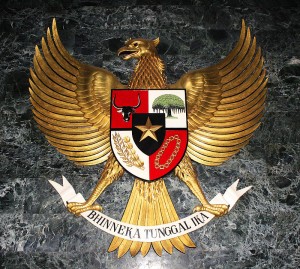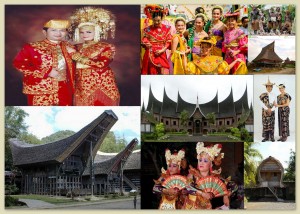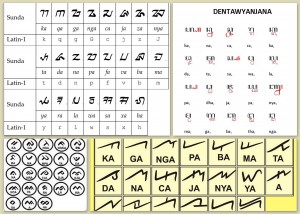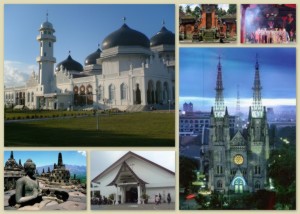Indonesia: An Overview of People, Culture, and Traditions Posted by asimonoff on Jul 19, 2014 in Uncategorized
Indonesia has an estimated 17,508 islands, but only 6,000 islands are inhabited. It comprises five main islands, which are Sumatra, Kalimantan (“Borneo”), Sulawesi (“Celebes”), Jawa (“Java”), and Papua (the western half of Papua New Guinea). With a population of 246,864,191 people, Indonesia is considered as the fourth most populous nation, and 58% of its people live in Java Island. The large population also brings about the diversity of cultures, ethnicities, religions, and languages that are found in everyday life.
One nation, one country, and one language
As one of the world’s most diverse countries, diversity is a central feature of Indonesian culture. It has 300 ethnic groups; 750 languages and dialects, with several local languages having their own scripts; and numerous religions, as a result of the country’s unique history and geography. The importance of diversity is embedded in the nation’s motto: Bhinneka Tunggal Ika (“Unity in diversity”). Even though Indonesians refer to themselves by their ethnic group and speak many local languages, they are united as a nation by Bahasa Indonesia, the official language of the country.
Ethnicity
Ninety-five percent of over 300 ethnic groups in Indonesia are of native Indonesian ancestry. The ethnic groups in Indonesia, in order of size, are as follows: Javanese, which makes up nearly 42% of the total population; Sundanese, 31%; Malay, 3.7%; Maduranese, 3.3%, and others, 26%. The Javanese live mostly in Java Island, but due to government transmigration programs, millions have migrated to other islands throughout the archipelago. There are also ethnic Chinese populations, which make up 1% of the total population. Indians and Arabs live mostly in urban areas.
Language
Bahasa Indonesia is the official language of Indonesia. It was the Malay language mainly spoken in the Riau islands and was later influenced by the local languages, cultures, and foreign languages that came with trade and other religions that were brought to the country. Bahasa Indonesia developed into a language independent of its roots, the Malay language. Even though Bahasa Indonesia has become the lingua franca, the local languages and dialects are still spoken by many Indonesians. To preserve the local cultures and languages, the Indonesian government, through its Ministry of Education, established policies for the local government to teach subjects relevant to the local cultures.
Religion
Although the country is predominantly Muslim, the government officially recognizes six religions. Islam is the country’s dominant religion, and most Muslims practice Sunni Islam of the Shafi’i school. Muslims make up about 88% of the Indonesian population; Christian Protestants and Roman Catholics make up roughly 10%; and Hindus, Buddhists, and Confucians make up 2%.
Society
Indonesia is a collectivist society that puts greater importance on the group rather than on individuals. This is the society’s way of life, and it is manifested in the form of mutual assistance (“gotong royong”) and consultations (“musyawarah”), which occur before arriving at a consensus (“mufakat”). The collectivist culture is also evident in the people’s long-term commitment to their family and extended family. The members of society form strong relationships in which everyone takes responsibility for the members of their group or clan. Indonesia does not have social security systems or welfare systems for every citizen; nevertheless, its collectivist culture ensures that citizens take care of one another when needed.

Build vocabulary, practice pronunciation, and more with Transparent Language Online. Available anytime, anywhere, on any device.
About the Author: asimonoff
I’m an Indonesian language instructor, instructional material developer, reading test developer, and interpreter. I have been teaching Indonesian to adult students for 15 years, and have been teaching students from many backgrounds, such as private, military and diplomatic service employees. I’m Indonesian, but am living in the US now; my exposure to different cultures in my home country and in the US has enriched my knowledge in teaching Indonesian as a second language. I approach the teaching of the Indonesian language by developing students’ critical cultural awareness and competence. This method of teaching has been proven to be a key to the success of my students. Students become conscious of the essential role culture plays in the language.







